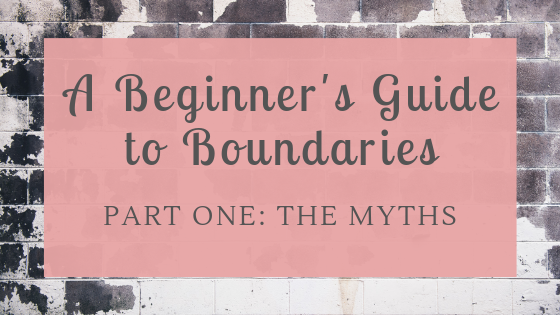Part One: The Myths of Boundary-Setting

A Beginner’s Guide to Boundaries is a three-part series on this important topic. To start the process, I will focus on identifying some of the myths about boundaries that I hear a lot. Then, when I’ve shared about what boundaries aren’t, I’ll talk about what they are and help reshape your thinking about how they can work for you in your life. Lastly, once you have a good understanding of boundaries and their role in your well-being, we’ll focus on how to effectively communicate them to others. If you’re new to the topic, it can be a lot to sort out! But for those willing to hang in there, most of those I know who have done the work feel so grateful when they get to the other side of the experience and find things changed for the better.
For many people, one of the biggest barriers to setting and maintaining interpersonal boundaries lives in their beliefs about what boundaries are and what role they play in healthy relationships. So before introducing the skills of setting effective boundaries, it is important to begin reshaping some of these thoughts to develop a more realistic understanding of the value of setting interpersonal limits. I’ve chosen a few of the most common misconceptions – I’ll break down the myth and share my thoughts on how to think differently about the issue.
- Boundaries are about being selfish, making myself a priority over others. The true goal of recognizing, establishing, and maintaining appropriate interpersonal boundaries is simply to know and honor your own wants and needs as much as you honor the wants and needs of others. When done well, boundaries do not establish an “I win, you lose” relationship; rather, they allow for genuine connection and promote genuine action. When we meet others’ needs from a sense of obligation, over time we may begin to feel overwhelmed and/or resentful. When we establish balanced relationships which meet the needs (relatively equally) of everyone involved, we tend to engage in those relationships with eagerness and joy. This is the gift of good boundaries.
- Having boundaries is just about learning to say “no.” It’s hard to imagine that so many people struggle in this area if it is as simple as uttering a two-letter word most of us effectively added to our vocabularies as toddlers. It’s true that saying “no” to others’ requests is more difficult for some than for others, and this is certainly relevant to the issue of boundaries. It is also true that as we come to understand our limits, this does mean we may say “no” to others sometimes. But having good boundaries is much more about knowing when to say “yes” than how to say “no.” Keeping the goal of genuine connection in mind, it is the selective use of “yes” that lives at the heart of setting and maintaining good interpersonal boundaries.
- Once I establish my boundaries, others should respect my limits and never challenge them. One of the biggest frustrations with early attempts to establish better boundaries inevitably occurs when someone identifies an opportunity to make a change, establishes a new limit, and sees others acting in ways which challenge their efforts. When this happens, it’s easy to believe boundary-setting will never work because, “people won’t respect my boundaries.” The truth is, boundaries belong to the person who sets them and can only be respected or disrespected, honored or dishonored, by that person. Others cannot be expected to enforce your limits for you, and it will take time for you to learn strategies to enforce them for yourself. But when you are consistently respecting your limits, others will eventually do the same because to do otherwise will be futile for them. This is the power of effectively setting (and maintaining) appropriate boundaries. (If this sounds impossible, hang in there! This is a tough one, but I’ll show you what I mean as we talk about identifying our boundaries and communicating them to others. You CAN do this!)
- I don’t need to set boundaries, because I am happy just to make others happy. Different people have different needs, so boundaries look differently for everyone. If you do well with very few interpersonal limits, that is great! The goal is only to know your personal limits and live within them. It feels good – and is important – to be available to help meet others’ needs. Developing mutually-satisfying relationships is a critical component of well-being, and even those who find joy in providing for others will have emerging needs (even if only relatively minimal). Being able to advocate for the meeting of those needs, by yourself and/or by others, is a skill from which all of us can benefit!
If this is an area where you have struggled, give yourself an opportunity to think about each of these myths. Read and re-read those which are most relevant for you. Consider what other thoughts about setting boundaries show up for you and may represent barriers to the goal of better balancing your needs alongside the needs of others. These exercises in self-reflection represent important preparation for beginning to develop a more thoughtful approach to making decisions about how you spend your time and energy. In part two of the series, Getting to Know Your Limits, we will think together about how to begin this process.
pm